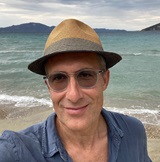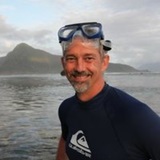Using Environmental DNA to Understand the Ecological Diversity of the Chumash Heritage National Marine Sanctuary

Inhabited by the Chumash peoples for over 10,000 years, the stretch of coast between the Monterey Bay and Channel Islands National Marine Sanctuaries are infused with cultural and ecological significance. The Chumash Heritage National Marine Sanctuary (CHNMS), the first to be Tribally nominated, is now in the scoping period for the designation process. During this stage, the National Oceanic and Atmospheric Administration (NOAA) prepares draft documents, such as a management plan, environmental impact statement, and proposed regulations for the sanctuary boundaries, that will benefit from additional scientific data and analyses.
The Lenfest Ocean Program joined forces with the Gordon and Betty Moore Foundation and Oceankind Labs to support Dr. Stephen Palumbi, Stanford University, and Dr. Stefano Mariani, Liverpool John Moores University, to use environmental DNA, or eDNA, to assess and monitor the distribution and structure of marine biodiversity in the CHNMS. The researchers will partner with Tribal leaders and experts to elucidate the relationship between traditional and scientific knowledge and engage community members in conducting the research. Through collaboration and knowledge sharing, our collective aim is to complement other efforts in the region, provide information that can be used by local communities and state managers, and inform the designation process for the CHNMS.
eDNA: A Dynamic Approach to Characterize and Monitor the Array of Life
The area of coastline being proposed for the CHNMS is home to a stunning diversity of habitats and plant and animal species long integral to the health and wellbeing of coastal communities. Utilizing eDNA involves gathering samples of soil, water, rock, sand, air and any other physical substrate and then sequencing DNA to characterize assemblages of species and their genetic variants. The power of this approach comes from a combination of its universality, breadth, and efficiency. It can be used to study the tree of life, from viruses to whales, and it is able to detect a greater number of species with a lower sampling effort than other survey methods. A vast amount of data can be retrieved from eDNA samples, and perhaps most notably, no animals are captured, distressed, or harmed in the process. The eDNA approach has the potential to complement other research efforts and strengthen our baseline understanding of the diversity and vitality of this unique coastline going forward.
Research Approach: Blending Data, Knowledge, and Community Engagement
In this project, the research team will use eDNA to describe and monitor species abundances and genetic diversity of fish, invertebrates, algae, and sea birds in the proposed CHNMS.
Sampling
The team will isolate organismal DNA from the kelp forest understory by collecting samples from kelp forest cobbles, water samples, and guano at an array of evenly spaced stations. They will include areas inside and outside the state marine reserves at Point Buchon, Vandenberg, and Point Conception. Samples will be gathered in the spring and fall—before and during upwelling—over the course of three years to detect seasonal and interannual patterns of species ranges and movements.
Analysis & Outputs
The team will then extract and sequence DNA. The analysis will allow them to produce a detailed geography for hundreds of coastal species, including identifying biodiversity ‘hotspots and coldspots’, as well as exploring the features of the ecosystem and food webs. They will track species ranges and abundances across the biogeographic break at Point Conception—one of the strongest climactic species-level abundance shifts—to detect non-native species invasions from southern coasts and link such dynamics to warming and potential climate-driven changes in upwelling patterns. They will test the impacts of the marine reserves by studying if species abundances vary over latitude differently inside or outside the reserve boundaries.
Community Collaboration & Education
The region encompassed by the proposed CHNMS has been home for millennia to the vibrant culture of the Northern Chumash Tribal community. It has been explored by scientists, adventurers, fishermen, and writers alike. The research team will work with educational liaisons on the Northern Chumash Tribal Council to engage students, fishers, and other community members in collecting data. They will compare observations with community members and seek insight on the historical context for patterns in species distributions, including what is known from cultural heritage sites, museum exhibits, ethno-botany records, oral histories, and other cultural records. Through such dialogue, the research team and the community hope to paint a much richer picture of coastal biodiversity.
Informing Area-Based Management and Sustaining Collaborations
The timeline for the project–late 2022 through Spring 2025–aligns well with the process leading up to the designation and implementation of the proposed CHNMS. In particular, the researchers will work with the Chumash community to understand how marine biodiversity historically important to Chumash culture is shaped by the environment through space and time, which could serve as a centerpiece for the Sanctuary’s research plan. In addition, the three state marine reserves within the CHNMS are part of California’s statewide network of Marine Protected Areas (MPAs). The state is now launching the Decadal Management Review to evaluate the network’s impact on ecosystem health. This project aims to inform that effort.
Finally, the researchers hope to document all shared learning and foster collaborative science for carrying forward monitoring and eDNA analysis beyond the life of the project. They will work with the Northern Chumash Tribal leaders, community members, other scientists and experts, and NOAA staff to develop operational field, lab, and computation protocols that can be continually applied and updated over time.
Contact
For questions, please contact Emily Knight, Lenfest Ocean Program, at [email protected]. To learn more about this research and stay up to date on our latest projects, follow us on Twitter @lenfestocean or sign up for our newsletter at www.lenfestocean.org.


